 Update: Thank you, Ginny, for helping us learn so much about foxes! If you missed it, a recording of this webinar is available on Wintonbury Land Trust’s YouTube Channel.
Update: Thank you, Ginny, for helping us learn so much about foxes! If you missed it, a recording of this webinar is available on Wintonbury Land Trust’s YouTube Channel.
Connecticut is home to two species of fox: the brilliantly colored Red Fox with its white-tipped tail and black legs celebrated in literature from Reynard the Fox to Fox in Socks by Dr. Seuss and the smaller, lesser-known Grey Fox which, believe it or not, can climb trees. These efficient omnivores play important roles in our ecosystem keeping the balance of nature in sync.
Tune-in to our next Nature Lecture to learn more about these fascinating creatures, including time for your questions. Ginny Apple, a State-certified Master Wildlife Conservationist, will lead our discussion. As a sportswriter and communications professional, she hiked, climbed, kayaked, skied, and poked her way through the outdoors. Now her home within Peoples State Forest in Barkhamsted, surrounded by bears and other wildlife, inspires her passion for sharing all things natural with us.
This free, informational webinar is a great way to learn about some of the wildlife in our community. You may participate on any device with a web browser and email access. Bloomfield Parks, Recreation & Leisure Services, our event co-sponsor, will host the webinar and email you the weblink when you register online.



Join us for the return of the Nature Lecture Series! These free, informational webinars are a great way to learn about wildlife in our community. Enjoy 60-minute live talks including a Question-and-Answer segment.
Our first webinar will present what you always wanted to know about raccoons, opossums, skunks, and porcupines. Often overlooked and misunderstood, these unique and fascinating animals have spectacular characteristics and adaptations for life in their environments. Come learn about these captivating critters that wander among nature – and our neighborhoods – with courage and tenacity.
Our presenter will be Ginny Apple, a State-certified Master Wildlife Conservationist inspired by a life filled with bears and other wildlife around her home within Peoples State Forest in Barkhamsted. Previously she was one of the first full-time women sportswriters in the country, and hiked, climbed, kayaked, skied, and poked her way through the outdoors developing a passion for all things natural.
The Nature Lecture Series is co-sponsored with Bloomfield Parks, Recreation & Leisure Services, who will host the webinar. You may participate on any device with a web browser and email access. A link to login will be sent to your email when you register online.
Update: Fifty-two hikers (and several dogs) kicked-off the New Year with Bloomfield’s second annual First Day hike at Wintonbury Hills Golf Course. Co-sponsored with Bloomfield Parks, Recreation, and Leisure Services, this year’s hikers enjoyed some sun and warm temperatures in the fifties, although a stiff breeze added a bit of chill.
The approximately 2.5-mile hike showcased the town’s award-winning golf course abuting Wintonbury Land Trust’s Beacon Hill Preserve. Some of the property along Duncaster Road once was part of A. C. Peterson Farms and nicely illustrates the rural character of western Bloomfield. As a result of continuing, thoughtful management it is certified as a Cooperative Bird Sanctuary by Audubon International.
Wintonbury Hills is closed for the season for golfers. During this hiatus, walkers are welcome to use the grounds as long as they stay on the cart paths. Snowshoeing also is allowed once there is snow. Take advantage of this opportunity to explore one of Bloomfield’s nicest walks and wonderful views. Once Spring arrives, it will belong again to the golfers!
(Photos: Paula Jones)
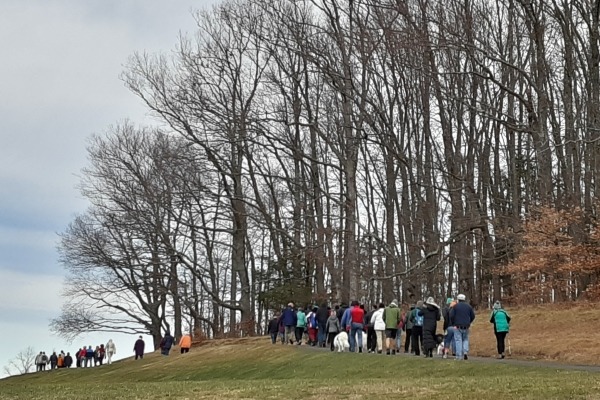


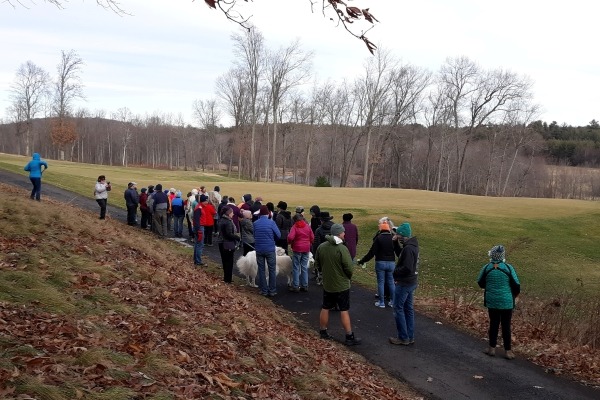


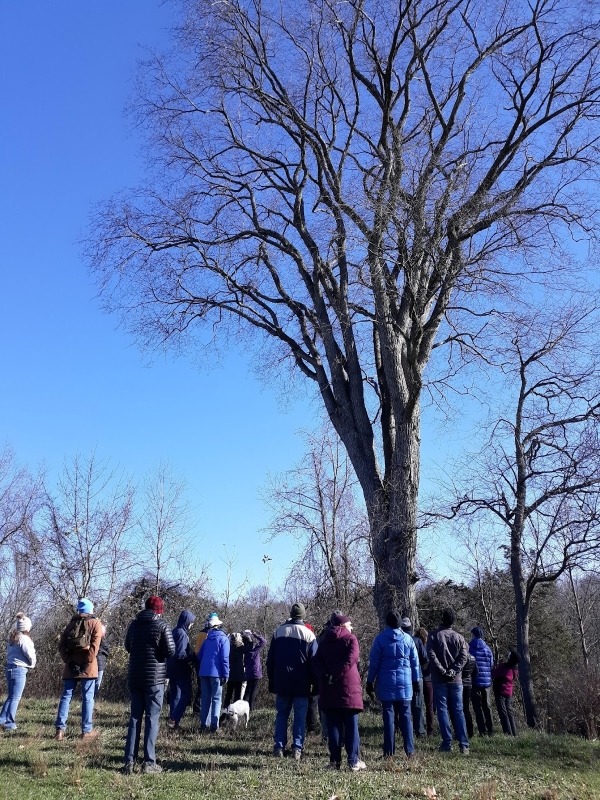


Connecticut’s Notable Tree Project identifies large and historic trees in the state, and Hawk Hill Farm contains a number of them. A White Oak on the property is in the top 50 in the state, and a Black Birch is in the top 12. Probably the most stunning tree on the property, however, is a magnificent American Elm classed in the top 25. With the spread of Dutch elm disease in the 1950s, it’s a treat to visit a surviving tree of this stature. Hikers easily can recognize it from the trail across the middle field. (Photo: Paula Jones)
Wintonbury Land Trust is in the process of enhancing its trails at the farm with a self-guided tree walk to showcase the trees at Hawk Hill.
Rescheduled from October 1 due to rain. Please re-register for the new date!
Wintonbury Land Trust’s Vic Herson, former executive director of the Knox Foundation, Ron Pitz, and Bloomfield’s Environmental Planner, Stephanie Bahramian, will lead an interactive workshop on invasive species in our Connecticut landscapes. Join fellow residents to tackle some of these plants at the Land Trust’s Hawk Hill Farm at 22 Duncaster Road.
You will walk away feeling confident in knowing how to identify and remove some of the harmful plants taking over our backyards and natural spaces while getting social and physical exercise. We recommend long pants and gloves. Please bring water, insect repellant, and any cutting and digging tools you have along with your fun spirit. RSVP online through our workshop co-sponsor, Bloomfield Public Library.
The Justice Dance Performance Project, founded in Hartford by Judy Dworin, is coming to Bloomfield’s Farmington River Park to perform a seasonal, dance theater work about the wisdom and value of trees, especially in the urban forest. “In the Presence of Trees” will highlight the hidden connections and communication among trees, and the lessons trees can teach us about communities, climate change, and the implications of environmental justice inequities.
Audience members will explore the autumnal beauty of Farmington River Park as they walk from the parking area to a forest clearing overlooking the river. Dancers will converge together to express the communal nature of the forest as it undergoes its fall metamorphosis. A Q&A talk back with the performers and artistic director will follow.
Tickets are free, but advance registration is requested. This project is graciously welcomed to Bloomfield by the Town’s TREES FOR BLOOMFIELD initiative, Bloomfield Leisure Services, Doll’s House Foundation, and Wintonbury Land Trust.
Update: With leaves beginning to burst forth with vibrant color, David Kozak, Kevin Gough, and Paula Jones led 30 participants “Over the Mountain.” The annual hike began at Simsbury Land Trust’s Owen-Mortimer Preserve, traversed Penwood State Park, and crossed Wintonbury Land Trust properties to reach Bloomfield’s Filley Park. Everyone enjoyed the 7-mile hike and were proud of their accomplishment of completing a hike of this distance.
Thanks to Bloomfield Parks, Recreation & Leisure Services for providing a shuttle and to Paula Jones for sharing pictures. Clockwise from top left: Views from the Pinnacle in Penwood State Park, gathering at Simsbury Land Trust’s Tanager Hill Preserve, hikers crossing Wintonbury Land Trust’s Stout Family Fields, and the White Trail developed by Wintonbury Land Trust volunteers at Bloomfield’s LaSalette Park.
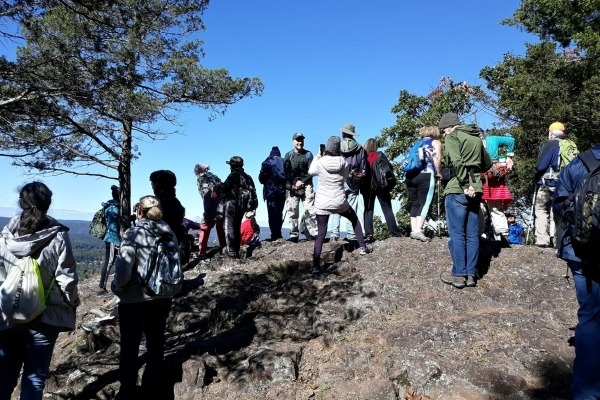


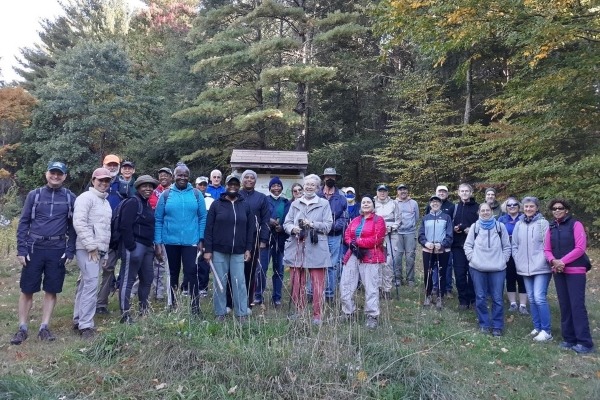


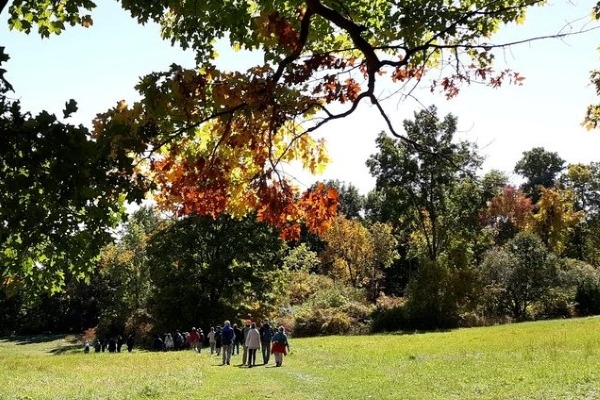


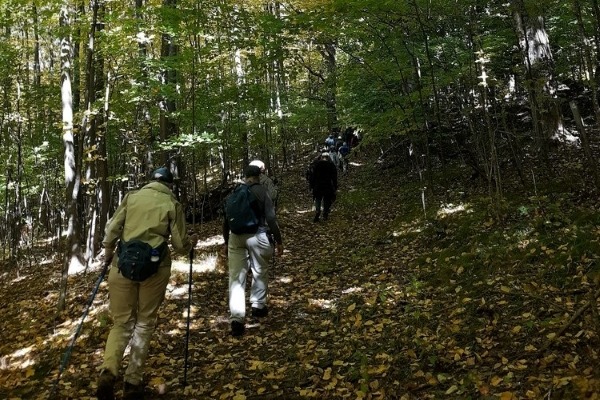





- Enjoy heavy hors d’oeuvres, sodas, beer, and wine (or additional drinks from a cash bar).
- Hear how your membership in the Land Trust supports our community.
- Be entertained by Bloomfield High School’s Voices of Inspiration chorus.
Also you can become a “Cool Cat in a Wintonbury Hat.” New and Current Members will receive our new Land Trust cap! Treat a friend to the party! If they become a Member that evening, your guest will receive a cap, too.
Register with a suggested minimum contribution of $20 per person by Saturday, September 17:
- Register & contribute online now with a credit card, or
- Download and print a PDF form to mail-in with a check.
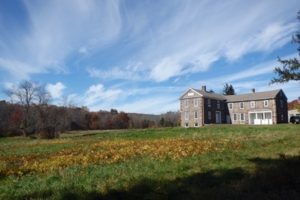


- Easy, guided walks will re-introduce the short trail between the community gardens and pond that has been renovated to be universally-accessible with support from the Hartford Foundation for Public Giving.
- The 1834 Oliver Filley House will be open for a rare opportunity to view the historic interior and the final opportunity to view the winning photographs from the Town’s TREES FOR BLOOMFIELD initiative 2021 photo contest.
- Short, guided tours of the park’s barns will highlight ongoing efforts to restore and maintain these historic structures.
The open house is part of “Celebrate Bloomfield,” an annual, town-wide event celebrating life in our community. Visit the website for a complete schedule of events August 25-28.
